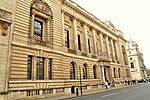British Tunnelling Society

The British Tunnelling Society (BTS) is a professional association established in London, UK, in 1971 by tunnelling professionals, led by Sir Harold Harding. The BTS is a learned society of the Institution of Civil Engineers, its mission being to provide a forum for meetings and discussion on tunnel-related matters. The BTS took part in the founding of the International Tunnelling Association (ITA) in 1974 and represents the UK on its General Assembly. In 2016, the BTS had 800 members making it one of the largest. The current chairman of the BTS, Kate Cooksey, assumed the position in May 2020. She is also the first female chairman of the Society.
Excerpt from the Wikipedia article British Tunnelling Society (License: CC BY-SA 3.0, Authors, Images).British Tunnelling Society
Great George Street, City of Westminster Millbank
Geographical coordinates (GPS) Address Nearby Places Show on map
Geographical coordinates (GPS)
| Latitude | Longitude |
|---|---|
| N 51.5011 ° | E -0.129 ° |
Address
Institution of Civil Engineers
Great George Street 1
SW1P 3AA City of Westminster, Millbank
England, United Kingdom
Open on Google Maps





